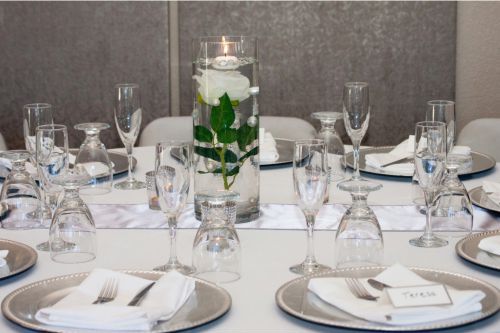
- How to Set a Table
- Why Proper Table Setting Still Matters Today
- A Beginner’s Guide | How to Set a Dining Table
- 5 Most Common Table Setting Mistakes to Avoid
- Decorating Tips Without Overdoing It
- Seasonal & Themed Table Setting Ideas
- FAQ: Proper Way to Set a Table
- Ready to Set Dinner Setting Like a Pro?
How to Set a Table
Learning how to set a dinner table is more than a matter of etiquette—it’s a way to elevate any meal, from casual weekday dinners to formal gatherings. Whether you're planning a dinner party or preparing a holiday celebration, table setting plays a vital role in enhancing your dining experience.
Many feel unsure about formal settings—where does the butter knife go? What about the salad fork or dessert spoon? This guide simplifies it all, helping you master casual and formal place settings while avoiding common mistakes.
We’ll cover everything from basic table setting steps to elegant arrangements, with expert tips to add that wow factor to any occasion.
Why Proper Table Setting Still Matters Today
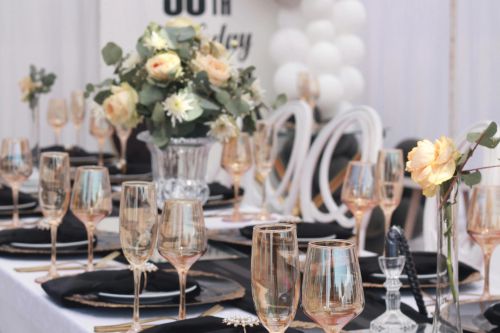
Setting the dinner table might feel old-fashioned in today's fast-paced world, but it remains one of the simplest ways to show thoughtfulness and hospitality. It sets the mood and tone for the meal. From an informal table setting for everyday dinners to formal table settings for weddings or holiday dinners, how you arrange your setting signals the importance of the occasion.
Reflects etiquette and attentiveness. A well-executed meal presentation shows you understand dining traditions, like placing the bread plate on the top left and the white wine glass to the right of the water glass. Provides meal structure. With every piece in its place—from the soup spoon to the dessert fork—your layout helps guests navigate through courses like soup, fish, and the main course seamlessly. A thoughtfully arranged table isn't just visually pleasing; it's a subtle way of saying, "You're welcome here."
A Beginner’s Guide | How to Set a Dining Table
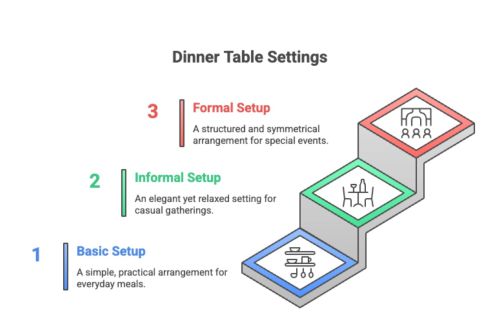
Casual Dinner Table Setup for Everyday Meals
A basic table setting can still feel polished and intentional. If you're serving a simple breakfast, lunch, or dinner, the basic table setting is quick, practical, and still neat:
Here's how to do it:
- Start with a tablecloth or placemats for a clean surface.
- Place the dinner plate in the centre.
- Fork goes to the left side, and the knife and spoon go to the right.
- The napkin can rest beneath the fork or atop the plate.
- A water glass is placed in the top right corner, above the knife.
This arrangement works for family dinners and quick gatherings. A basic table setting helps you get comfortable with more formal layouts.
Informal Dinner Table Setup: Hosting with Ease
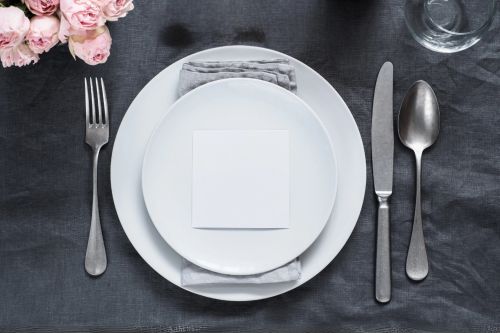
Planning a laid-back dinner with friends or family? An informal dinner table setting adds elegance without feeling stuffy. Here’s what to include:
- Dinner plate
- Salad plate (placed on top of the dinner plate)
- Forks (salad fork outside, dinner fork inside)
- Knife and spoon
- Water glass and wine glass
- Cloth napkin (optional napkin ring for flair)
Tips for success:
- Use a table runner or placemats to add texture and warmth
- Include simple centerpiece like candles or a floral arrangement
- Make sure everything is aligned and evenly spaced for a balanced look
How to Set a Formal Table
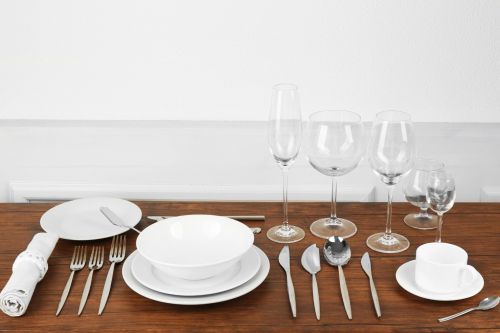
Hosting a holiday or black-tie dinner? The formal dinner table setting is about structure and symmetry. It may look intimidating, but once you understand the order, it's surprisingly straightforward. Formal settings are ideal for weddings, corporate dinners, and holidays.
Glassware, Plates & Napkin Etiquette
- Charger Plate: Base layer for all other plates
- Soup Bowl: If serving soup, place it on top of the salad plate
- Salad Plate: Goes above the dinner plate if not stacked
- Bread Plate & Butter Knife: Top left, butter knife laid horizontally
- Napkin: Folded neatly or placed inside a napkin ring, to the left or on the plate
- Glassware: Water goblet closest to the plate, followed by red and white wine glasses to the right
Utensil Placement & Serving Tips
- Start from the outside and work your way in
- Left side: salad fork, then dinner fork (closest to plate)
- Right side: soup spoon, salad knife, dinner knife
- Dessert spoon/fork placed horizontally above the plate
This step-by-step guide to setting a dinner table ensures that each utensil aligns with the appropriate course, such as the soup course, fish course, or main course.
5 Most Common Table Setting Mistakes to Avoid
Even with the best intentions, it's easy to make small errors that throw off the look and flow of your dinner table setup. When learning how to set a dinner table, avoiding these 5 common mistakes will help ensure your layout is both functional and visually appealing.
| Mistake | Why It’s a Problem | How to Fix It |
|---|---|---|
| 1. Swapping fork and knife sides | Disrupts the flow and breaks basic etiquette | Place the fork on the left, knife on the right, blade inward |
| 2. Incorrect glassware placement | Guests may reach for the wrong glass; layout feels unbalanced | Start with the water glass, then white wine, then red wine |
| 3. Skipping napkin or water glass | Makes the table feel incomplete or thoughtless | Always include a napkin and water glass, even in casual meals |
| 4. Overcrowding with unused utensils | Causes confusion and makes the table look cluttered | Only place utensils needed for the dishes being served |
| 5. Misplacing dessert utensils | Breaks formal setting conventions and disrupts symmetry | Place dessert utensils above the dinner plate, centered |
Top Table Setting Mistakes (and How to Fix Them)
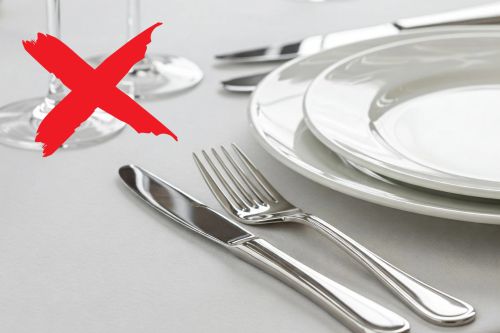
Here are 5 dinner table setting mistakes to watch out for—and how to avoid them.
#1: Swapping the Fork and Knife Placement
Swapping fork and knife sides is a frequent error. Remember, the dinner fork belongs on the left, and the dinner knife should be placed on the right of the dinner plate. It may seem like a small detail, but it directly impacts the flow of the meal.
#2: Incorrect Glassware Arrangement
Another common mistake is glassware confusion. Always place the water glass first, on the far left of the setting, and then arrange the wine glasses to the right of it, starting with the white wine glass and followed by the red wine glass. This ensures that each glass is easily accessible and in the proper order for different courses. Ignoring symmetry can also disrupt the harmony of your meal arrangement; every place setting should mirror the other across the setting for balance and elegance.
#3: Ignoring Functional Table Layouts
Forgetting functional layouts is a big mistake. While some may opt for a simpler arrangement with only the fork at informal meals, it’s important to include a napkin and a water glass, especially when entertaining guests.
#4: Overcrowding with Unused Utensils
Overcrowding utensils can also clutter the table—there’s no need to add utensils that won’t be used for the entire meal, so avoid placing them unnecessarily.
#5: Placing Dessert Utensils Incorrectly
Lastly, a major faux pas is the wrong placement of dessert cutlery. These should be positioned at the top of the setting, above the dinner plate, rather than beside it. Understanding the correct way to set a meal arrangement will help you create a layout that is not only functional but also visually pleasing, ensuring that your setup impresses your guests while providing a seamless dining experience.
To avoid common pitfalls in table setting etiquette, like confusing glassware placement or swapping fork and knife sides, check out this Table Setting Etiquette 101 guide from the Auguste Escoffier School of Culinary Arts.
Decorating Tips Without Overdoing It
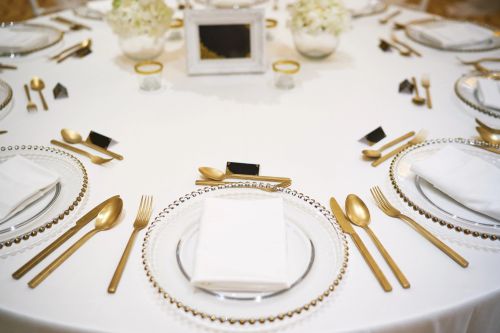
Centerpieces and Table Runners That Work
The right decorations can enhance but not overpower your setting.
- Keep centerpieces below eye level for easy conversation.
- Use a narrow dining setup that complement rather than clash with your tablecloth.
- Consider minimalist options for modern styling of the dining area ideas, such as greenery, candles, or stones.
When preparing the meal setup for guests, balance is key. Avoid cluttering the table with excess accessories. Decor doesn’t have to be complicated. For creative yet simple inspiration on how to decorate a dinner setting space with purpose, check out these tips on creating beautiful table settings from Deseret Industries.
Napkins, Chargers & Glassware—Styling with Purpose
- Match your glassware to the beverages. Red wine needs a wider bowl; white wine, a narrower one.
- Use charger plates to frame the meal setting.
- Decorative napkin rings elevate cloth napkins, especially during special occasions.
- Don’t forget the coffee cup, especially for formal meals that end with dessert and espresso.
These small enhancements to your dining space setup can elevate the experience without making it look overdone.
Seasonal & Themed Table Setting Ideas
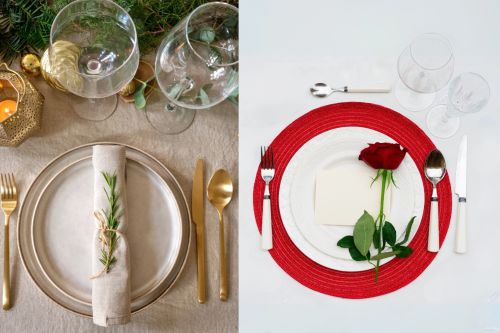
Table decor changes with the occasion.
- Christmas feast table setup: Use red, green, and gold accents; small ornaments make fun placeholders.
- Easter dinner table setting ideas: Think pastel colour palettes and floral napkin holders.
- Valentine dinner table setting ideas: Candles, rose petals, and white wine glasses create intimacy.
- Birthday dinner table decorations: Balloons and personalized name cards.
- Romantic dinner table setup: Keep it soft, candle-lit, and uncluttered.
Coordinating dishware, napkins, and centerpieces based on the event adds intention to every gathering.
FAQ: Proper Way to Set a Table
1. How do I remember where things go?
Use the BMW method: Bread on the left, Meal in the center, Water on the right. The butter plate sits above the forks, with the butter knife placed horizontally.
2. What’s the easiest table setting layout when I’m unsure?
Go with a no-fail layout:
- Plate in the center
- Forks on the left
- Knife and spoon on the right
- Napkin beside or on the plate
- Water glass above the knife
3. What’s the difference between a charger plate and a dinner plate?
A charger plate is a decorative base placed under the dinner plate. It's not used for food directly but enhances presentation during formal meals.
4. How many glasses are used in a formal dinner setting?
Typically, you'll use three glasses: a water goblet, white wine glass, and red wine glass. Add a champagne flute for toasts if needed.
5. Where do specialty utensils and items like the dessert fork or coffee cup go?
- Dessert fork: above the plate
- Fish knife: to the right of the dinner knife
- Red wine glass: right of the white wine glass
- Coffee cup: far top right corner of the setting
Understanding formal dining behaviour goes beyond where the forks go. These dining etiquette tips from Kent State offer deeper insights into the do’s and don’ts of mealtime interactions, especially useful during dinner parties or formal occasions.
Ready to Set Dinner Setting Like a Pro?
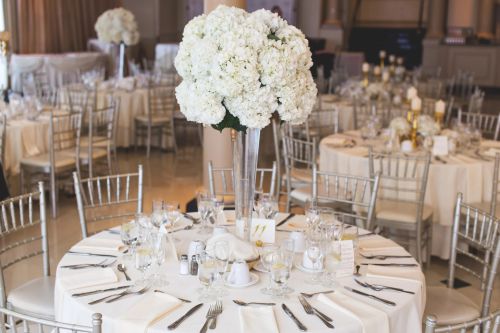
Knowing how to set a dinner table correctly is an art that blends style, etiquette, and intention. Whether you're preparing a formal place setting for a wedding or organizing a basic dining area for everyday dinners, the goal remains the same—creating a space that feels welcoming and polished. With the steps, tips, and tools shared above, you’re now equipped to set the perfect table for any occasion.
Now that you know where each fork, glass, and plate belongs—from the top of the salad plate to the right of the dinner plate—you can approach any gathering with confidence. Setting the dining area thoughtfully isn’t just about following rules. It’s about creating an experience that lingers long after the meal is done. Try your favourite layout tonight, or share this guide with a friend who’s hosting soon.
Want to impress during the holidays? Check out our other helpful article, “Thanksgiving Dinner Table Setting" , for expert tips on creating the perfect Thanksgiving table setup.

